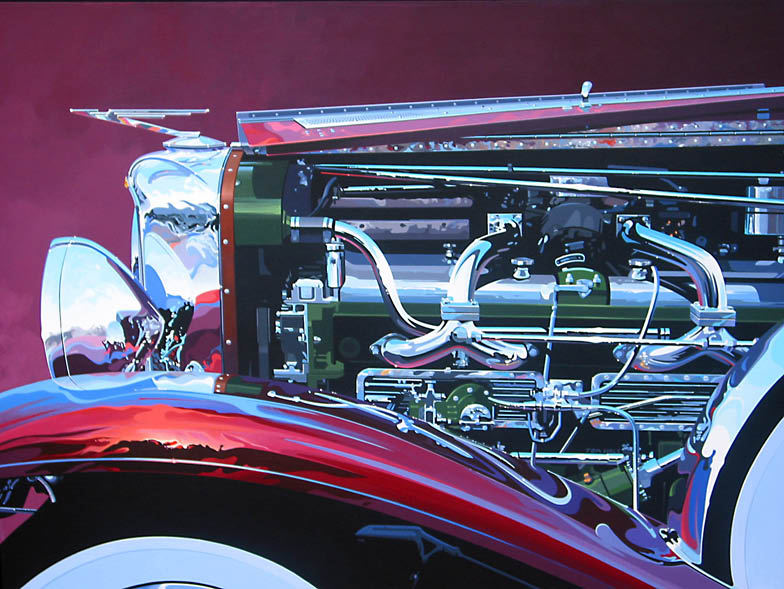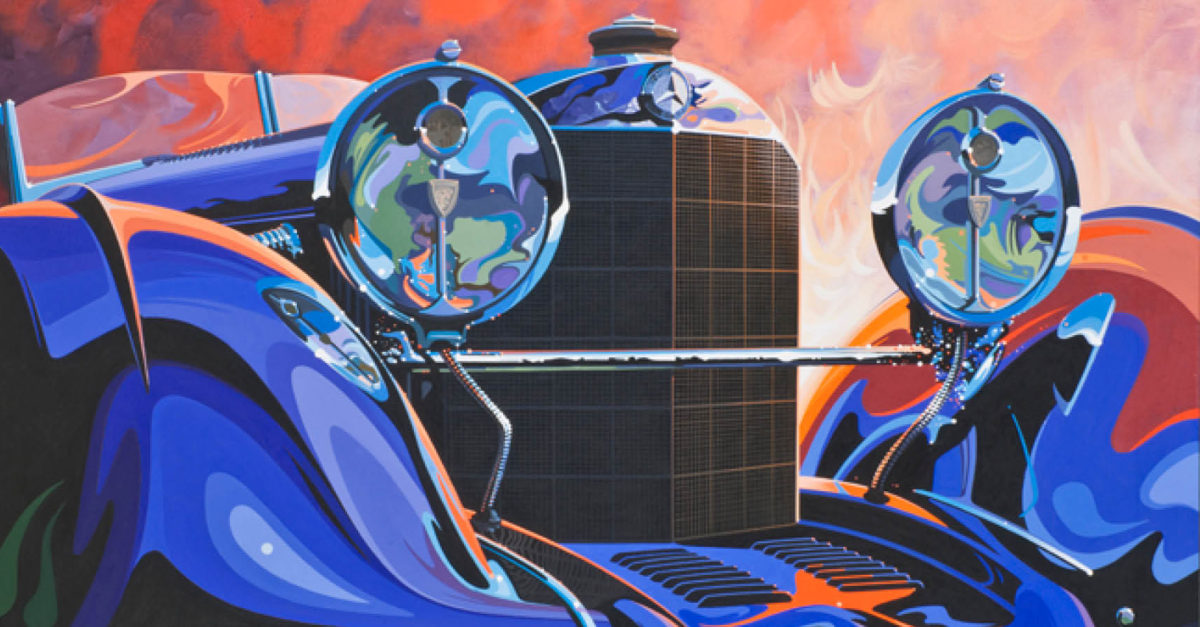Acrylic and Chrome: Classic Automobile Paintings by Tom Hale
Did you enjoy making art from a young age?
I began drawing cars at around seven years old, like most young boys. I’d set up some orange crates as a table and start drawing. My family was never very wealthy, so I didn’t have a lot of fancy tools or anything, but a pencil and paper really were all it took. The difference is, unlike other kids, I never stopped.
Were your parents interested in your artistic talent?
In a sense, yes. As a child, I would draw a car as my mom and dad watched TV. I’d show them the drawing and excitedly ask, “What do you think?” They’d say, “Oh, that’s really nice, Tom,” and probably assumed my love for art was maybe going to go away. But, on the other hand, they didn’t discourage it. They saw that I was interested in it, and they let me do it. They gave me that freedom. When I look back, I think that decision was really important.
Why did you gravitate toward cars as a subject matter?
From early on, cars fascinated me. My dad worked for Chrysler, and in the middle-to late 1950s, I’d travel with him quite a bit. I’d sit in cars in the showroom and study them.
Plus, I grew up in the Detroit area, so it was really easy to be influenced by automobiles. All of this led me to want to create my own image of a car and design it.
As time went on, I kept drawing and ultimately wanted to become a car designer. So I just kept working at my automobile drawings in my spare time. As a young adult, I was stationed on a Navy destroyer for a couple of years, and I had an area where I could sit and draw after work hours. I prepared a portfolio that ultimately landed me at the single most important school in the world for automotive styling: the Art Center School in Los Angeles, California. I graduated in 1966 and then worked as a stylist for twenty years at General Motors, Chrysler, and American Motors.

Did you enjoy working for car companies?
I loved the work! I would sit at a drawing board almost every day and draw future cars, or sometimes just their details, such as a new grille texture or a new taillight. However, I didn’t function well in corporate life. I was restless, opinionated, and very frustrated because my creativity wasn’t
being maximized. So, on my lunch hours, I started painting watercolors of old barns, buildings, and landscapes as a relief.
How did you become a professional artist?
I accumulated a group of my paintings and put them into a gallery. I sold a couple, and then, during vacations and other spare time, I started doing some art shows around the country. Little did I know I was creating a second career! In 1985, after twenty years in the business, I just walked away from the corporate job. My late wife, Micki, and I always had a sense of adventure, and we found that going to art shows allowed us to get to know new people from all walks of life. It was really exciting to us.
Do you use acrylic paints?
Yes. The thing I like about acrylics is they can be used in a very transparent, watercolor way and can be applied to almost any surface. My favorite way to paint is acrylics on canvas. I’m used to the rapid drying: Acrylics dry very quickly, sometimes too quickly. It can be difficult to blend colors, unlike oil or even watercolor.
What’s your process for creating works of art?
I walk around at a lot of high-end automotive shows, and every once in a while, I’ll see something that gives me an idea for a painting. I may take a hundred photographs for reference because there’s no way I can remember all the details of every car. I then create all the color and the reflections. When I see a certain door cut on the side of a car, that’s enough information for me to know how to cast reflections because I understand the surfaces based on my work as a car stylist. For larger paintings, the whole process can take six to eight weeks. People say, “You’re born with talent.” To me, it’s really about hard work. I obviously had enough interest to pursue art, but it’s all about work and persistence.
Do you get more inspired in the showroom or after you see the photos?
I probably get most inspired when I see the car—or part of the car. When I do, I can actually see the finished painting that I want to do in my head, before I even touch the canvas. I can clearly see what I want to do, and that becomes the incentive that carries me through the weeks of creating that painting. I never quite seem to reach that image in my mind, but on really rare occasions I do, and sometimes I actually go beyond that and do something even more exciting than I had initially envisioned. I get in a zone, and everything happens just perfectly. It’s like I can’t make a mistake. I’m talking about a rare, brief moment, but it’s almost like I can taste the colors as I’m painting them, as strange as that may sound. What I’m sensing is how everything comes together, right at that moment, in a very magical, wonderful way.

Do you prefer to focus on the full car or a section of the car?
You’ll notice that I do very few full-size paintings of cars. I get a lot of people who want me to do a painting of their car. They’re looking for me to paint a picture of their car, but that’s not really what I do. I use cars to make what I hope are works of art. I’m just using the car as my subject, and I’m not anxious to just make pictures of cars. Instead, I see a lot of compositional opportunities within the detail areas. I see opportunities to do some things with color and reflections, which is why approximately 90 percent of my paintings are of sections of cars.
Talk about why reflections and floral images are a big part of your art:
I take total liberty with reflections. I create them. They’re not based on photographs. They’re not done on a computer. People always want to know how I paint chrome, for example. In a lot of my paintings, the chrome is very reflective, even though it’s just flat paint. Some people actually think I buy a tube of chrome paint! But the image is just an illusion I create using technique. It’s no different than going to a museum and seeing a beautiful portrait of a person, and the skin looks so real. Well, that artist simply knew enough about how to depict skin realistically. To me, that’s all chrome is: just an illusion.
The reflections led to incorporating floral images into my art. One time, I did a painting of an old Chrysler Imperial, and the reflections were nothing but abstract shapes of color. Micki looked at it and asked why I put a red tulip on the side of the hood. I told her it wasn’t a tulip, just a red shape. But I started thinking about how incredible flowers are in terms of color, sensuality, and beauty. I was also thinking that automobiles are one of the greatest things created by man. So I realized that the two subjects really complement one another. That’s why I started putting the floral images in with the cars.
Your paintings gravitate toward striking purples and blues. Is that your style, or is it what works for your subject?
My style just evolved. I didn’t pick a particular style like some artists try to, but what I do now has become what people call my style. Color, though, is a fearful thing for many artists. I have other problems, but color’s not one of them. I’ve never had a fear of color. I like to paint mostly dark cars, and when you see a dark car outside with a brilliant blue sky, all the top surfaces of the car turn blue, so that accounts for some of my interest in blue. And, of course, blue is easy to transform into purple, which is one of my favorite colors. I can paint a brilliant red car, but I can put a blue shape right on top of that red and make it work. So when I start painting, I can pretty much do anything I want with color and, in most cases, make it work.

Do you consider cars themselves to be works of art?
Certainly most cars are not works of art. Most are produced commercially to make money, and a lot of compromises are made along the way. However, some cars have been produced as a result of pure passion, with no particular goal of selling them. Those cars, such as the Talbot-Lago, Duesenberg, Delahaye, and Cord, are absolutely works of art to me. Museums are starting to recognize that, too. There have been some important museum shows in the past few years featuring cars as art.
Of all the cars that you’ve painted, do you have a favorite?
The Duesenberg. For me, it represents the ultimate classic automobile, and I don’t know if there are any two Duesenbergs that are quite alike. The Duesenberg is a 1930s car.
Are you interested in that era?
Yes. The other decade that interests me is the 1950s, the chrome era. Some of the ultimate chrome cars, like the 1958 Buick, are just loaded with chrome. But that’s the decade in which I grew up, and that’s when I started really paying attention to cars. So those are the two eras that interest me the most.

What other interests do you have besides painting?
To others, it might sound awfully boring, but I’m totally focused on painting. That really takes care of me. I love painting today more than I ever have! And I’m not lacking for anything else. I’ve done a little boating and fishing. I go to movies, stuff like that. But the art and the automobiles are all-consuming.
You’ve received several awards for your art. Does any particular one mean more to you?
The one that really has meaning for me is the Gold Medal of Honor from the American Watercolor Society, perhaps the most prestigious watercolor society in the country. I submitted a painting of a 1932 Duesenberg called Chrome, and I ended up winning the society’s top award, which, in its 113-year history, had never been awarded to an automotive subject. Today, the society is in its 150th year, and no other automotive subject has ever won the gold medal. That is so significant to me because the automobile is considered such a commercial subject that a lot of museums, and many art critics, don’t take it seriously. So getting that top award was really satisfying and validating.
Is that what you hope your overall body of work will help to accomplish?
Yes. I know a handful of artists who are focused on the automobile and are making some incredible art, whether it’s two-dimensional or three-dimensional, and I think, beyond my lifetime, some of this work is going to be highly collectible because the automobile always reflects our times.
For more info, visit tomhalegallery.com.






















